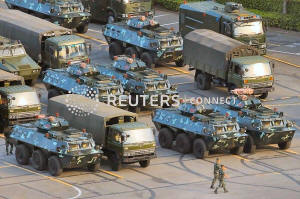In 'clear warning', Chinese paramilitary forces exercise near Hong Kong
 Send a link to a friend
Send a link to a friend
 [August 15, 2019]
By Brenda Goh and Greg Torode [August 15, 2019]
By Brenda Goh and Greg Torode
SHENZHEN, China/HONG KONG (Reuters) -
Hundreds of members of China's People's Armed Police could be seen
conducting exercises on Thursday at a sports stadium in Shenzhen, as the
U.S. State Department expressed concern that they could be deployed
across the border in Hong Kong to break up protests wracking the city.
But Western and Asian diplomats in Hong Kong said Beijing has little
appetite for rolling the PAP or the People's Liberation Army onto Hong
Kong's streets.
On Thursday men in fatigues could be seen in a stadium and shouts and
whistles could be heard by a Reuters journalist. The stadium is next to
a retail complex and shoppers were milling around the area, although the
entrances to the stadium were closed.
Parking spaces at the stadium were filled with more than 100
dark-painted paramilitary vehicles, including troop trucks, armored
personnel carriers, buses and jeeps. At least three were armored
wheel-loaders, and two vehicles carried water cannons.

"This is the first time I've seen such a large-scale meeting," said Yang
Ying, a receptionist at a wellness center inside the stadium's retail
complex.
"There have been exercises in the past, but usually they involve traffic
police," she added. "Our friends, social media all say it's because of
Hong Kong."
Ten weeks of increasingly violent confrontations between police and
protesters have plunged Hong Kong into its worst crisis since it
reverted from British to Chinese rule in 1997.
The protests represent one of the biggest challenges for Chinese
President Xi Jinping since he came to power in 2012.
On Wednesday the U.S. State Department said it was deeply concerned
about reports that Chinese police forces were gathering near the border
with Hong Kong and urged the city's government to respect freedom of
speech.
Troops marched in and out of the Shenzhen stadium, some in fatigues,
some in black T-shirts and camouflage trousers. The floor of an indoor
area visible through an open gate was lined with mats and rucksacks.
Chinese state media have made several mentions of exercises in Shenzhen.
The Global Times, a nationalistic tabloid run by the ruling Communist
Party's official People's Daily, published a slick video early this week
showing columns of trucks and armored personnel carriers rolling through
the city.
The paper said the vehicles belonged to the People's Armed Police and
had gathered for "apparent-large scale exercises." Its editor, Hu Xijin,
described it on Twitter as "a clear warning to rioters in Hong Kong."
The Communist Party's official People's Daily newspaper said on the
social media platform Weibo that the force handles incidents that
include riots and terrorist attacks.
[to top of second column]
|

Military vehicles are parked on the grounds of the Shenzhen Bay
Sports Center in Shenzhen, China August 15, 2019. REUTERS/Thomas
Peter

"There is usually PAP in Shenzhen, but this time it appears to
directed against Hong Kong," said a taxi driver, who gave his
surname as Wang. "Usually they wouldn't hold such a big exercise."
POSTURING, FOR NOW
Still, diplomats in Hong Kong said they believe Chinese leadership
is well aware that moving mainland forces into Hong Kong would
shatter international faith in the "one country, two systems" model
at the heart of Hong Kong's role as a global financial hub, and
would swiftly lead to sanctions.
"We are seeing an escalation in the posturing that appears designed
to send messages to both Hong Kong and the mainland ... but we are
confident we are still in the realms of propaganda here," one senior
Western envoy told Reuters, speaking on condition of anonymity
because he was not authorized to speak to the media. "The trucks
aren't about to roll at this point."
Alexander Neill, a Singapore-based security analyst at the
International Institute of Strategic Studies, said it would take far
more serious scenarios to spark such a move.
"I think we'd really need to see a total breakdown and a sense that
China's national interests were at great risk and could not be
protected by the Hong Kong government and its police," he said.
Worst-case scenarios, he said, could involve the assassination or
kidnapping of Chinese officials in Hong Kong, the sacking and
occupation of key offices there or the government's losing control
of parts of the police force.
"We're a long way from anything like that yet, so I think what we
are seeing is harder posturing that is part of a much broader
propaganda effort underway on many fronts," he said.
The Shenzhen stadium sits across the water from Hong Kong's rural
hinterland, near a bridge straddling the border.

People working around the stadium said the level of PAP activity was
higher than they had ever seen, but not disruptive, as the troops
usually kept to themselves.
The chief disruption was PAP vehicles occupying parking spaces, and
people who worked in the area said they'd been told not to share
pictures of vehicles.
(Reporting by Brenda Goh and Greg Torode; Additional reporting by
Tom Westbrook; Writing by Tony Munroe; Editing by Gerry Doyle)
[© 2019 Thomson Reuters. All rights
reserved.]
Copyright 2019 Reuters. All rights reserved. This material may not be published,
broadcast, rewritten or redistributed.
Thompson Reuters is solely responsible for this content. |